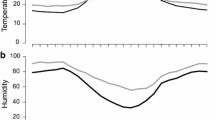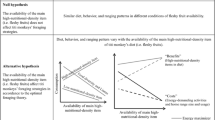Abstract—Foraging techniques influence the morphological peculiarities and ecological specialization of species, also determining their organization in a community. The foraging behavior of forest ground insectivorous birds remains the least explored due to the difficulty of observing them in the wild. We studied the foraging behavior of four nightingale species in an outdoor aviary where they were given a choice of typical foraging substrates. Two categories of young birds took part in the experiment: hand-raised and wild birds. Five aspects of behavior were recorded: foraging intensity, structure of background activity, attack maneuvers, attack direction, and substrate preference. The coefficients for converting the noted activity into energy expenditure units were developed. The behavioral parameters, except for the intensity of foraging, were expressed as the proportion of total energy expenditure for a given behavioral aspect, reducing the variation of these parameters related to a change in activity. Three principal components explain more than three-quarters of the interspecific differences in individual behavioral parameters. The first component corresponds to the foraging intensity and ranks the species according to decreasing body mass. The second component distinguishes the tactics of the Siberian Rubythroat as complex exploration of dense vegetation thickets from the tactics of the Rufous-tailed Robin as detailed extensive ground surface exploration. The third component contrasts the tactics of the Bluethroat (alternation of moving, waiting, and long sally-hovers) to the tactics of the Siberian Blue Robin (intensive short aerial attacks). The species-specific foraging traits appear in young birds independently of the wildlife experience. While learning by doing, they increase the foraging intensity and strengthen specific behavioral traits. The type of substrate determined the foraging intensity and ratio of the expenditure for search, movement, and attacks. Foraging techniques and their direction are correlated with other behavioral aspects, but are partly determined by the preference of specific preys and their properties. Despite the well-marked distinctions, the foraging niches of the nightingales strongly overlap; i.e., each behavioral aspect of the species studied is dominated by basic, less specialized elements.













Similar content being viewed by others
REFERENCES
Baranovskii, A.V., Khlebosolov, E.I., Marochkina, E.A., Anan’eva, S.I., Chel’tsov, N.V., and Lobov, I.V., Mechanisms of ecological segregation of four cohabiting species of thrushes—fieldfare Turdus pilaris, redwing T. iliacus, song thrush T. philomelos, and blackbird T. merula, Russ. Ornitol. Zh., 2007, vol. 16, express issue 377, pp 1219–1230.
Batova, O.N., Selection of foraging tactics in leaf warblers (Phylloscopus), Biol. Bull. (Moscow), 2011, vol. 38, no. 3, pp. 259–265.
Bourski, O.V., Nest distribution of passerine birds in the Yenisei taiga as a reflection of the ecological features of species, in Fauna i ekologiya ptits i mlekopitayushchikh Srednei Sibiri (Fauna and Ecology of Birds and Mammals in Central Siberia), Moscow: Nauka, 1987, pp. 108–142.
Bourski, O.V., Kontorshchikov, V.V., and Batova, O.N., Stereotypes of foraging behavior of the willow warbler (Phylloscopus trochilus) and common chiffchaff (Ph. collybita), Zool. Zh., 2004, vol. 83, no. 76, pp. 839–850.
Clement, P. and Hathway, R., Thrushes. Helm Identification Guides, London: Christopher Helm, 2000.
Dol’nik, V.R., Resursy energii i vremeni u ptits v prirode (Energy and Time Resources in Birds in Nature), St. Petersburg: Nauka, 1995.
Emlen, J.T. and DeJong, M.J., Intrinsic factors in the selection of foraging substrates by pine warblers: a test of a hypothesis, Auk, 1981, vol. 98, no. 2, pp. 294–298.
Golovatin, M.G., Troficheskie otnosheniya vorob’inykh ptits na severnoi granitse rasprostraneniya lesov (Trophic Relationships of Passerine Birds at the Northern Boundary of Forests Distribution), Yekaterinburg: Ur. Otd., Ross. Akad. Nauk, 1992.
Greenberg, R., Neophobia in the foraging-site selection of a neotropical migrant bird: an experimental study, Proc. Natl. Acad. Sci. U.S.A., 1984, vol. 81, pp. 3778–3780.
Holmes, R.T. and Recher, H.F., Determinants of guild structure in forest bird communities: an intercontinental comparison, Condor, 1986, vol. 88, no. 4, pp. 427–439.
Holmes, R.T. and Robinson, S.K., Spatial patterns, foraging tactics, and diets of ground-foraging birds in a northern hardwoods forest, Wilson Bull., 1988, vol. 100, no. 3, pp. 377–394.
Hutto, R.L., Habitat selection by nonbreeding, migratory land birds, in Habitat Selection in Birds, Cody, M.L., Ed., Orlando, Florida: Academic Press, 1985, pp. 455–476.
Khlebosolov, E.I., The stereotype of foraging behavior of birds, Usp. Sovrem. Biol., 1993, vol. 113, no. 6, pp. 717–730.
Landmann, A. and Winding, N., Niche segregation in high-altitude Himalayan chats (Aves, Turdidae): does morphology match ecology?, Oecologia, 1993, vol. 95, no. 4, pp. 506–519.
Leisler, B. and Winkler, H., Ecomorphology, in Current Ornithology, New York: Plenum, 1985, vol. 2, рр. 155–186.
MacArthur, R.H., Population ecology of some warblers of northeastern coniferous forests, Ecology, 1958, vol. 39, no. 4, pp. 599–619.
Mills, A.M., Foraging segregation in a breeding bird guild declines following nesting, Can. J. Zool., 2007, vol. 85, no. 1, pp. 141–150.
Parrish, J.D., Experimental evidence for intrinsic microhabitat preferences in the black-throated green warbler, Condor, 1995, vol. 97, no. 4, pp. 935–943.
Partridge, L., Field and laboratory observations on the foraging and feeding techniques of blue tits (Parus caeruleus) and coal tits (P. ater) in relation to their habitats, Anim. Behav., 1976, vol. 24, no. 3, pp. 534–544.
Promptov, A.N., Ocherki po probleme biologicheskoi adaptatsii povedeniya vorob’inykh ptits (Essays on the Problem of Biological Adaptation of Behavior of Passerine Birds), Moscow: Akad. Nauk SSSR, 1956.
Razeng, E. and Watson, D.M., Nutritional composition of the preferred prey of insectivorous birds: popularity reflects quality, J. Avian Biol., 2015, vol. 46, no. 1, pp. 89–96.
Remsen, J.V., Jr. and Robinson, S.K., A classification scheme for foraging behavior of birds in terrestrial habitats, Stud. Avian Biol., 1990, vol. 13, pp. 114–160.
Robinson, S.K. and Holmes, R.T., Foraging behavior of forest birds: the relationships among search tactics, diet, and habitat structure, Ecology, 1982, vol. 63, no. 6, pp. 1918–1931.
Ryabitsev, V.K., Territorial’nye otnosheniya i dinamika soobshchestv ptits v Subarktike (Territorial Relationships and Dynamics of Bird Communities in the Subarctic), Yekaterinburg: Nauka, 1993.
StatSoft, Inc., STATISTICA (data analysis software system), version 8.0, 2008. www.statsoft.com.
Vladyshevskii, D.V., Foraging ecology of forest birds, in Ekologiya pitaniya lesnykh zhivotnykh (Foraging Ecology of Forest Animals), Novosibirsk: Nauka, 1978, pp. 5–36.
Vladyshevskii, D.V., Ekologiya lesnykh ptits i zverei (kormodobyvanie i ego biotsenoticheskoe znachenie) (Ecology of Forest Birds and Animals (Foraging and Its Biocenotic Significance)), Novosibirsk: Nauka, 1980.
Wiens, J.A., On competition and variable environments, Am. Sci., 1977, vol. 65, no. 5, pp. 590–597.
ACKNOWLEDGMENTS
The author is grateful to A.I. Panaiotidi and O.N. Batova for assistance in organizing the work, K. Welsher and P. Leopold for participating in observations, and T.A. Ilyina for discussing the manuscript. This study was supported by the Russian Foundation for Basic Research, project no. 15-04-08491.
Author information
Authors and Affiliations
Corresponding author
Additional information
Translated by L. Solovyova
Rights and permissions
About this article
Cite this article
Bourski, O.V. Foraging Behavior of Nightingales (Luscinia Supergenus): An Experimental Study. Biol Bull Russ Acad Sci 45, 812–830 (2018). https://doi.org/10.1134/S1062359018080034
Received:
Published:
Issue Date:
DOI: https://doi.org/10.1134/S1062359018080034




